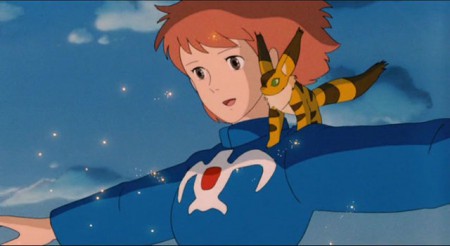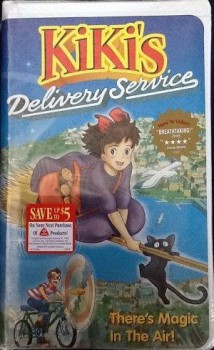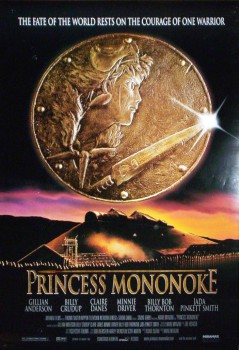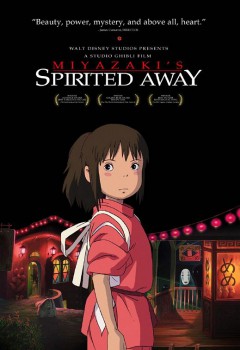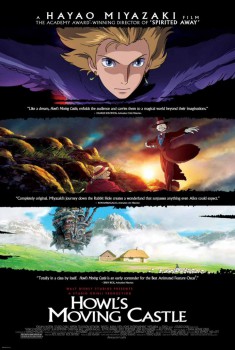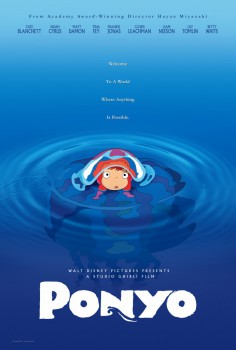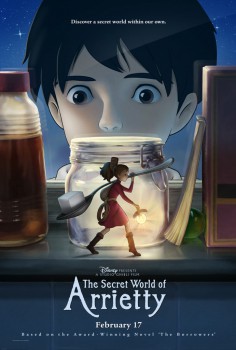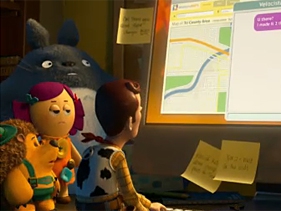Mickey’s Neighbor Totoro – The History of Disney and Studio Ghibli
Ghibli is an Arabic word that literally means “hot air blowing in from the Sahara Desert” and is pronounced with a hard “gah” sound (Giblee). In the same way that Disney became a commonly heard name after the success of Mickey Mouse, Ghibli became a commonly heard word with a different pronunciation thanks to Hayao Myazaki. After having success in Japan with his first independent film, Nausicaä of the Valley of the Wind, Myazaki formed his own studio with the profits and chose this word due to its relevance to the theme of Nausicaä. Mispronouncing it with a soft “j” sound (Jiblee) Studio Ghibli was born, bringing this unlikely word into the lives of millions of people all over the world.
However, Myazaki wasn’t able to fully back his studio with the money made from Nausicaä. In 1985, he found a financial partnership with a publishing company called Tokuma Shoten. Tokuma would financially back and produce most of Studio Ghibli’s films and distribute them in Japan. Similar to Disney’s early days, the studio produced hit after hit, primarily from Myazaki and his friend Isao Takahata. Films like Castle in the Sky, My Neighbor Totoro, and Kiki’s Deliver Service helped secure a future for the studio and generated international interest. One of Ghibli’s first international endeavors came in 1988 when a new L.A. company called Streamline Pictures acquired the rights to dub their films in English for use on transpacific Japan Airlines flights. Twentieth Century Fox bought the home video rights to this version of My Neighbor Totoro and released it on VHS in 1993. While Fox now had the U.S. rights to one of Studio Ghibli’s most popular films (and mascot character), Studio Ghibli had also attracted the attention of another company whose history had so many parallels.Myazaki was looking for a way to pay back Tokuma Shoten for their investment, since animated films were so expensive and Ghibli was averaging about one film every two years. In 1996, Disney and Tokuma signed a complex contract that granted Disney U.S. home video rights to select Ghibli films (the deal excluded Totoro and another Ghibli film that Tokuma didn’t finance called Grave of the Fireflies) in addition to home video rights to all Ghibli films within Japan. With the agreement, Disney also gained international distribution rights for Ghibli’s upcoming film Mononoke Hime (Pincess Mononoke). Disney’s first use of this deal in the Unites States was an English dub of Kiki’s Delivery Service, a European inspired story about a young witch making a name for herself in a small village. Disney was able to assemble an all-star voice cast including Kristen Dunst, Debbie Reynolds, and Phil Hartman, to whom the English language version is dedicated (it was his final film). Kiki premiered in the U.S. on home video on September 1st, 1998, on VHS and Laserdisc. While the name “Studio Ghibli” was absent from the marketing for this release, Disney included an ad for their next release, Castle in the Sky. While the dub was made, Disney scrapped plans for its 1999 home video release. The reasons are unknown, but it can be assumed that Kiki didn’t sell strongly enough to justify future releases.
Myazaki had been burned by foreign language adaptations of his films when Nausicaä was edited for its English language dub in 1985, becoming Warriors of the Wind with a run time of 95 minutes (the original film ran 117 minutes). As a result, the terms of Disney’s contract didn’t allow for much creative license. Disney requested some edits to Mononoke to make it more family friendly, but Myazaki refused. Their faithful adaptation received a PG-13 rating and Disney wasn’t yet ready to allow a film carrying their name to receive that rating. As a result, Princess Mononoke was distributed in a limited release by Miramax on October 29th, 1999 with a voice cast that included Claire Danes, Minnie Driver and Billy Bob Thornton. With little marketing, it didn’t cause much of a splash at the box office.
By 2000, it would appear that Disney wasn’t getting much out of the deal with Tokuma, but it is important to remember that Studio Ghibli’s films were enormously successful in Japan and Disney was also profiting off the home video sales there. It is likely for these reasons that Disney decided to start contributing to production costs of their films. Disney’s contract with Tokuma was extended with an agreement that Disney would pay 10% of the production costs of future films in exchange for right of first refusal for American distribution. The first film under the new contract was My Neighbors the Yamadas. Disney first took advantage of this deal with Spirited Away, the film that put Studio Ghibli on the map for Disney fans. With a dub supervised by head of Pixar and friend of Myazaki John Lasseter, Disney’s bond with Studio Ghibli was strengthened. Disney let the film tour the film festival circuit and gave it a short release in September 2002 to qualify for an Academy Award nomination. After it won the Best Animated Feature Oscar in 2003 (beating Lilo & Stitch), Disney quickly put together a nationwide release that March. Disney’s dub grossed $10 million domestically and marketing included the Studio Ghibli name, creating a brand presence for these films in America. Now that the brand was there, Disney used the success of Spirited Away to attract viewers back to Kiki’s Delivery Service and Castle in the Sky by simultaneously releasing all three of them on DVD on April 15th, 2003. Marketing for Spirited Away advertised all three films and presented them as a collection from Studio Ghibli. Suddenly a studio that previously would only appeal to a small population of anime enthusiasts had film buffs and Disney fans singing it’s praises and clamoring for more. Myazaki’s next major film, Howl’s Moving Castle, was almost complete and Disney was eager to decrease the gap between the Japanese release and the American release of these increasingly popular films. While Howl made its Japanese premier in November, 2004, Disney was able to produce the dub with Lasseter and have it ready for U.S. theatrical release on June 10th, 2005. With less critical attention and released away from Oscar season, the film earned $5 million, half of what Spirited Away accomplished. In a cross-promotional effort, Disney released three more Studio Ghibli films on home video in advance of Howl’s theatrical release. The flagship title of this wave was Nausicaä of the Valley of the Wind, the film responsible for the creation of Studio Ghibli. There must have been a sense of personal victory for Myazaki as well, knowing that his ambitious film finally had a worthwhile release stateside.
Howl made its home video debut on March 7th, 2006, accompanied by Whisper of the Heart, My Neighbors the Yamadas, and one more film. Fox’s rights to Totoro had expired in 2004 and Disney was quick to buy it. Lasseter produced Disney’s dub, which featured Dakota Fanning and her sister Elle as the young sisters that meet the strange forest spirit Totoro, with Pat Carroll and Lea Solonga providing additional voices.
The next film Disney was eligible to release domestically was Ponyo, a Hayao Myazaki film loosely inspired by The Little Mermaid. With cute kid characters that would appeal to a younger audience, Disney cast Frankie Jonas (“The Bonus Jonas”) as Sosuke, the little boy who finds a fish named Ponyo, voiced by Noah Cyrus, Miley’s sister. With a built-in adult fan base, Disney cast Matt Damon, Cloris Leachman, Tina Fey, Betty White, Lilly Tomlin, Liam Neeson, and Kate Blanchette to voice the adult characters. A heavy marketing campaign succeeded, earning $15 million for Disney in 2009. Tales from Earthsea was released in Japan in 2006, a film directed by Hayao Myazaki’s son Goro. However, the book series upon which the film was based was also used for a TV movie on Sci-Fi Channel in 2004, which prevented Disney from releasing it in the United States until 2010. The film had a much darker tone than Spirited Away and Howl and was both a critical and financial flop domestically. The film also carried a PG-13 rating with it, the first time Disney has released an animated film with a rating higher than PG. With sales so low, some may have worried that the magical partnership was over. In September 2011, Disney made a decision to no longer be the exclusive American distributor of Studio Ghibli films, making an agreement with a company called GKIDS (Guerrilla Kids International Distribution Syndicate). Disney signed over theatrical distribution rights to thirteen Studio Ghibli films (including a film Disney has never released on home video called Only Yesterday). While Disney still owns home video rights to all of these films, GKIDS is able to use them theatrically, where they have been frequently shown at animation film festivals ever since. Hayao’s next film was based on a popular children’s book called The Borrowers by Mary Norton, which was developed into a live action film in 1997 starring John Goodman. In Japan, the film was released as simply Arrietty on July 17th, 2010, but Disney wanted a catchier title and renamed it The Secret World of Arrietty. Disney Channel stars Bridget Mendler and David Henrie voiced the main characters, while Carol Burnette, Amy Poehler, and Will Arnett created adult appeal for the English dub. Disney struck gold making nearly $20 million domestically in 2012, the most successful Studio Ghibli film in America to date.In 2013, Disney gave its first pass on a Studio Ghibli film that it coproduced in Japan and the North American rights appropriately went to GKIDS. With an English dub produced by Kennedy/Marshall (who produced the dubs for Ponyo and Arrietty) and a voice cast including Jamie Lee Curtis and Ron Howard, From Up on Poppy Hill hit theaters on March 15th in a limited release. It’s a charming sentimental film about students in 1964 Yokohama fighting to save their school’s clubhouse. Disney has had the most success promoting Ghibli films with a magical element, which this film lacks. This is presumably the reason Disney passed on their option for this film. Studio Ghibli celebrates its 30th anniversary next year. Studio head and acclaimed director Hayao Myazaki retired from directing last year with the release of his final film, The Wind Rises. How fitting that his final film would have the word "wind" in the title, giving everything we now know about the studio's creation. Disney screened the film in L.A. last November to qualify it for Academy Award nominations, which earned the film a nomination up against Disney’s Frozen. With a PG-13 rating for “some disturbing images and smoking,” Disney has opted to release the film theatrically through its Touchstone Pictures distribution label. It opened in a limited release on February 21st and goes into wide release on February 28th. Whether you’re a fan of Studio Ghibli or not, you are sure to have felt its influence in some way over the past decade. The animation teams at Disney and Pixar are both huge fans of the studio that Nausicaä built, drawing inspiration from many of these films. Studio Ghibli was including nods to previous and upcoming projects within their films long before Pixar and Disney started doing it. They’ve even snuck in a few references to Studio Ghibli in recent years. The most notable is this little (or should I say big?) cameo in Toy Story 3. An entire generation has had the chance to grow up with these films thanks to Disney. The next time you see a girl running around with a broom between her legs pretending to fly, she may have been inspired to do so by Kiki. The next time you see children running around a forest looking for large beasts, the creature they search for might just be Totoro. And the next time you see a kid with a fish in a bucket trying to talk to it, they may be expecting a big adventure in the style of Ponyo. But more likely than any of these scenarios is seeing an adult dressed in cosplay as any character from a Studio Ghibli film at the next comic or Disney convention you attend.
Alex is currently watching and reviewing all of Disney’s films in chronological order. You can follow along here.



